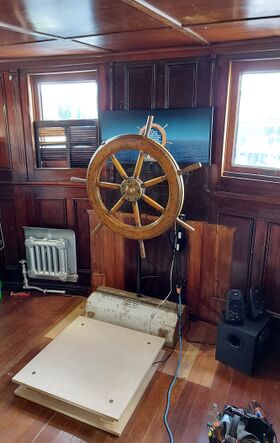Range Lights Interactive Museum Display: Difference between revisions
Ttenbergen (talk | contribs) No edit summary |
Ttenbergen (talk | contribs) No edit summary |
||
| Line 1: | Line 1: | ||
{{Project}} | {{Project}} | ||
The [[Selkirk Marine Museum]] asked us to set up a display about [https://en.wikipedia.org/w/index.php?title=Range_light Range Lights], maritime navigation aids that help a vessel stay in a channel. We set up an [[Interactive Display]] that uses an [[Arduino]] to detect the movement of a [https://en.wikipedia.org/wiki/Ship%27s_wheel ship's wheel], which lets the user control a display created in [[Pygame]] on a [[Raspberry Pi]] that simulates | |||
The [[Selkirk Marine Museum | |||
steering a ship to bring it in line with a set of range lights. | steering a ship to bring it in line with a set of range lights. | ||
Revision as of 20:13, 2021 October 27
| Projects | |

| |
| Project: | Range Lights Interactive Museum Display (I) |
| Description: | |
| Skillset(s) : |
3D Modelling • 3D Printing • Arduino • Electronics • Graphic Design • Making • Programming • Python • Raspberry Pi |
| Project Type(s) : | |
The Selkirk Marine Museum asked us to set up a display about Range Lights, maritime navigation aids that help a vessel stay in a channel. We set up an Interactive Display that uses an Arduino to detect the movement of a ship's wheel, which lets the user control a display created in Pygame on a Raspberry Pi that simulates steering a ship to bring it in line with a set of range lights.
The museum provided an antique ship's wheel for this. We designed, 3d printed and integrated the hall sensors into the wheel to measure the wheel movement via quadrature encoding. We also provided the graphics and video components for the game.